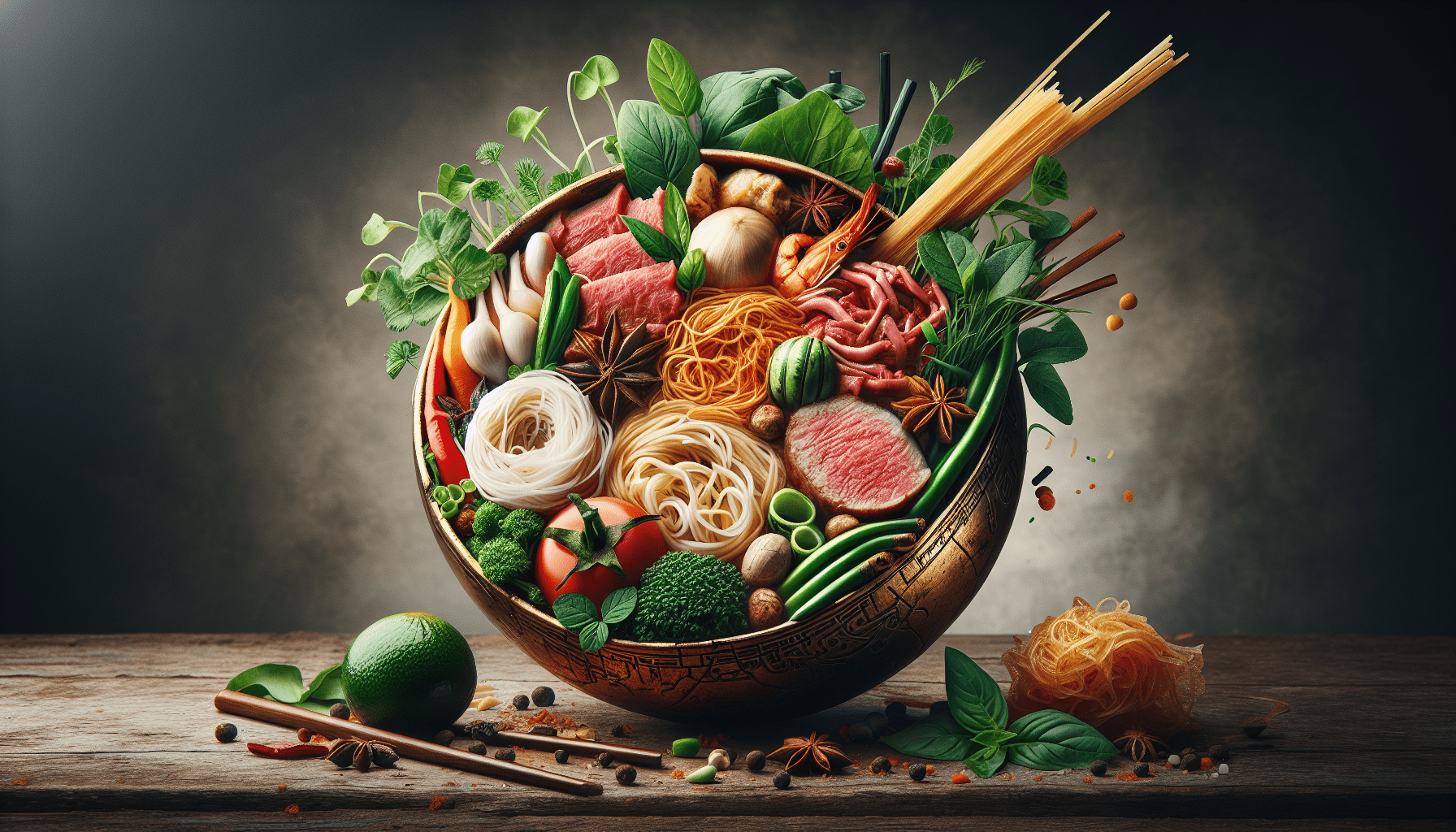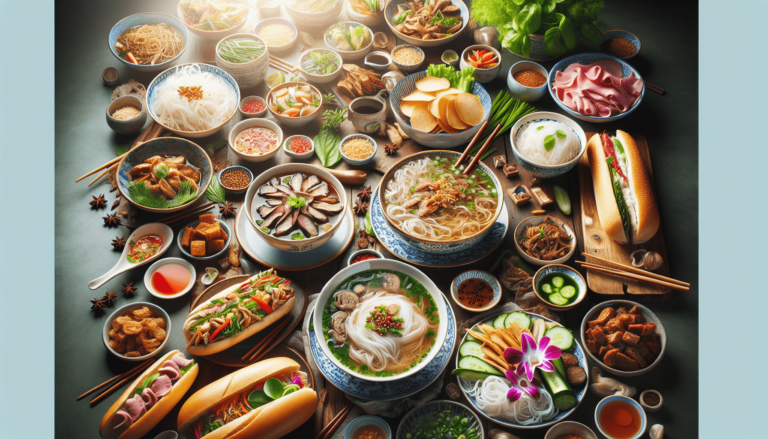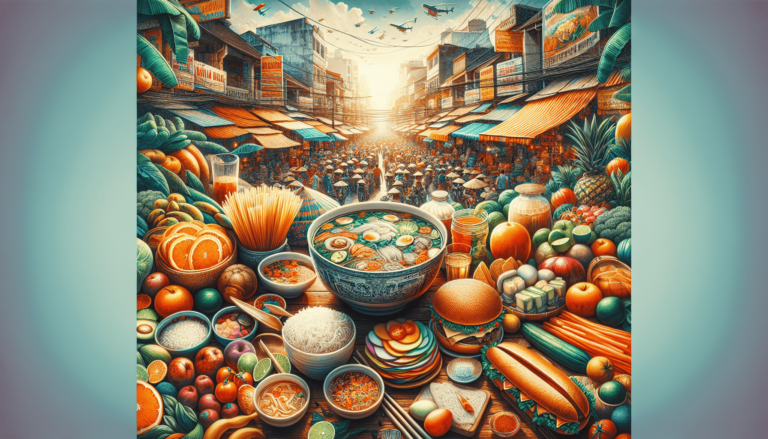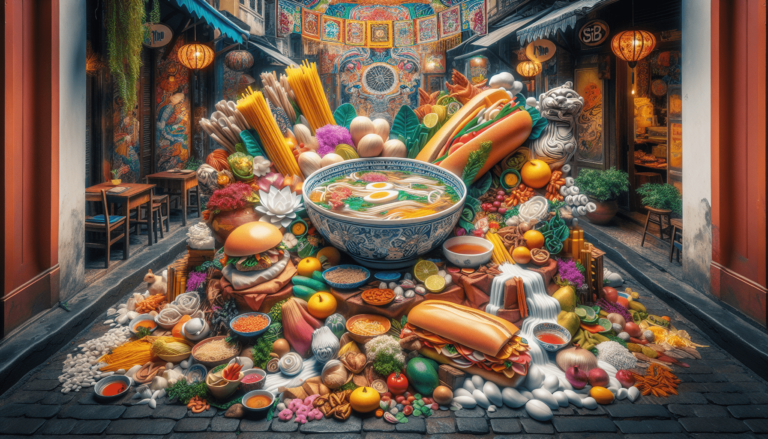Have you ever wondered about the flavors and ingredients that make up Vietnamese style food? From fresh herbs to bold spices, Vietnamese cuisine is known for its vibrant flavors and enticing aromas. Whether it’s the famous pho, the savory banh mi, or the refreshing spring rolls, Vietnamese dishes offer a unique culinary experience that combines influences from both East and West. If you find yourself craving a taste of this delicious cuisine, why not visit one of the Eurasian Bistro locations in Pensacola? With their extensive menu and dedication to authentic flavors, they are the perfect place to explore the wonders of Vietnamese style food.

The basics of Vietnamese cuisine
Vietnamese cuisine is known for its vibrant flavors, fresh ingredients, and unique cooking techniques. It has been influenced by a rich history and a combination of various cultures, resulting in a diverse and exciting culinary experience. To truly appreciate Vietnamese cuisine, it is essential to understand its historical influences, common ingredients used, and the predominant flavors that make it so special.
Historical influences
Vietnamese cuisine has been shaped by multiple historical influences, including Chinese, French, and Southeast Asian cultures. Chinese influence can be seen in the use of stir-frying, rice noodles, and the tradition of eating family-style. The French introduced baguettes, pate, and other elements of French cuisine, which gave birth to the famous Vietnamese sandwich, Bánh mì. The Southeast Asian influence can be observed in the use of aromatic herbs, spices, and tropical fruits.
Common ingredients used
Vietnamese cuisine utilizes a variety of ingredients that contribute to its unique flavors and textures. Rice is a staple in Vietnam, and dishes such as Phở (noodle soup) and Bún chả (grilled pork & noodles) often feature rice noodles. Fresh herbs like mint, coriander, and Thai basil, along with vegetables like bean sprouts and lettuce, are commonly used for added freshness and crunch. Fish sauce, soy sauce, and shrimp paste provide depth and umami flavors, while lemongrass, ginger, and garlic add aromatic and zesty notes.
Predominant flavors in Vietnamese dishes
Vietnamese cuisine is characterized by a delicate balance of flavors, with an emphasis on freshness and subtlety. Sweet, sour, salty, and spicy are the main flavors that harmoniously come together in a single dish. The flavors are achieved through the combination of ingredients and the expert use of herbs, spices, and sauces. The Vietnamese believe in preserving the natural flavors of the ingredients, allowing each element to shine through without overpowering the dish as a whole.
Signature dishes in Vietnamese Cuisine
Vietnamese cuisine offers a wide range of signature dishes that have gained international recognition for their unique taste and culinary artistry. Here are a few of the most beloved dishes that you must try when exploring Vietnamese cuisine.
Phở: The Vietnamese Noodle Soup
Phở, a fragrant and hearty noodle soup, is perhaps the most famous Vietnamese dish. It typically consists of beef or chicken broth, rice noodles, and a variety of herbs and toppings. The combination of slow-cooked broth, tender meat, and aromatic herbs creates a flavorful and comforting bowl that is both satisfying and nourishing.
Bánh mì: The Vietnamese Sandwich
The Bánh mì sandwich is the result of the French influence on Vietnamese cuisine. It is made with a crispy baguette filled with various ingredients such as grilled meats, pickled vegetables, cucumbers, cilantro, and a tangy sauce. This fusion of French and Vietnamese flavors creates a delightful combination of textures and tastes that is both familiar and refreshing.
Gỏi cuốn: Vietnamese Spring Rolls
Gỏi cuốn, also known as fresh spring rolls or summer rolls, are a popular Vietnamese appetizer. They are made by wrapping a combination of rice noodles, shrimp, pork, herbs, and vegetables in translucent rice paper. These refreshing rolls are typically served with a dipping sauce, such as hoisin sauce or peanut sauce, and provide a light and healthy option for those craving a burst of flavors.
Bún chả: Grilled Pork & Noodles
Bún chả is a Vietnamese dish that features grilled pork served with rice vermicelli noodles, fresh herbs, and a tangy dipping sauce. The grilled pork is marinated in a combination of garlic, lemongrass, and fish sauce, imparting a smoky and fragrant flavor. This dish is often accompanied by a side of pickled vegetables, providing a balance of textures and tastes.
Vietnamese Seafood Dishes
With a long coastline and an abundance of rivers, Vietnamese cuisine incorporates a variety of seafood into its repertoire. From traditional preparations to innovative dishes, here are a couple of Vietnamese seafood delicacies that are worth exploring.
Chả Cá Lã Vọng: Tumeric Fish Noodles
Chả Cá Lã Vọng is a famous Hanoi specialty that showcases the unique flavors of turmeric-marinated fish. The fish is typically grilled or pan-fried and served on a sizzling hot plate. It is accompanied by rice noodles, fresh herbs, peanuts, and a tangy dipping sauce. The combination of fragrant turmeric, tender fish, and vibrant herbs creates a dish that is both aromatic and full of umami flavors.
Cá Kho Tộ: Caramelised Fish in Clay Pot
Cá Kho Tộ is a traditional Vietnamese dish that highlights the art of caramelization. It consists of catfish or other types of fish that are braised in a clay pot with a rich caramel sauce, fish sauce, ginger, and garlic. The slow-cooking process allows the flavors to meld together, resulting in tender fish with a sweet and savory caramel sauce. This dish is often enjoyed with steamed rice, providing a wonderful balance of textures and flavors.
Vegetarian Vietnamese Dishes
Vietnamese cuisine offers numerous vegetarian options, allowing those with dietary preferences or restrictions to still enjoy the rich flavors and diverse range of dishes. Here are a couple of popular vegetarian Vietnamese dishes that are both satisfying and delicious.
Bún chay: Vegetarian Noodle Salad
Bún chay is a vibrant vegetarian noodle salad that features rice vermicelli noodles topped with an array of fresh vegetables, fragrant herbs, and sometimes tofu or seitan for protein. The toppings can vary, but common additions include lettuce, bean sprouts, cucumber, and pickled carrots. The salad is typically dressed with a tangy nuoc cham sauce, creating a refreshing and wholesome meal.
Phở chay: Vegetarian Pho
Phở chay is a vegetarian version of the traditional Phở noodle soup. Instead of meat, this version typically includes tofu, mushrooms, and assorted vegetables, such as bok choy and bean sprouts. The broth is still rich and flavorful, thanks to the use of aromatic spices and herbs. This comforting bowl of vegetarian goodness is perfect for those seeking a hearty and nourishing option.

Vietnamese Desserts
Vietnamese desserts are a delightful end to any meal, offering a contrast of flavors and textures that satisfy the sweet tooth. From sweet soups to luscious cakes, here are a few Vietnamese desserts that are sure to leave a lasting impression.
Chè: Sweet Soup
Chè is a popular Vietnamese dessert that comes in many variations. It typically consists of a sweet soup made with mung beans, lotus seeds, coconut milk, and various types of beans, fruits, or jelly. Chè can be enjoyed hot or cold, and it provides a refreshing and indulgent treat that is both satisfying and comforting.
Bánh bò: Steamed Rice Cake
Bánh bò is a beloved Vietnamese dessert known for its unique texture and mild sweetness. It is a steamed rice cake made from rice flour, coconut milk, and sugar. The cake has a soft and slightly chewy consistency, with a honeycomb-like pattern running through its center. Bánh bò is often enjoyed with a cup of hot tea and is a delightful treat for any occasion.
Bánh flan: Vietnamese Crème Caramel
Bánh flan is a Vietnamese take on the classic crème caramel dessert. It features a smooth and creamy custard topped with a caramel sauce. The custard is typically flavored with fragrant ingredients such as vanilla or pandan. Bánh flan is velvety, rich, and slightly sweet, making it the perfect ending to a Vietnamese meal.
Use of herbs and spices in Vietnamese food
Herbs and spices play a crucial role in Vietnamese cuisine, adding layers of flavor and complexity to dishes. From common herbs and spices to their specific use and impact, here is a deeper look into the world of Vietnamese culinary herbs and spices.
Common herbs and spices
Vietnamese cuisine is known for its abundant use of fresh herbs and aromatic spices. Some common herbs include mint, basil, cilantro, and Vietnamese coriander, known as rau răm. Aromatic spices often used include lemongrass, ginger, garlic, star anise, cinnamon, and cloves. These herbs and spices contribute to the distinct flavors and fragrances that embody Vietnamese cuisine.
Use of herbs and spices in dishes
Herbs and spices are integral to Vietnamese dishes, added at different stages of cooking to maximize their flavors. Lemongrass is often pounded or finely chopped and added to marinades and soups to infuse dishes with its citrusy aroma. Ginger and garlic are frequently used to add depth and warmth to stir-fries and braised dishes. A combination of star anise, cinnamon, and cloves creates the aromatic base for broths like Phở, while Vietnamese coriander adds a peppery and earthy flavor to salads and noodle dishes.
Impact on flavor and health benefits
The herbs and spices used in Vietnamese cuisine not only enhance the flavors of dishes but also offer numerous health benefits. Mint and basil provide a refreshing, cooling effect and are rich in antioxidants. Lemongrass has antimicrobial and anti-inflammatory properties, while ginger is known for its digestive and immune-boosting properties. Garlic has been used for centuries for its medicinal properties, such as reducing cholesterol levels. These herbs and spices not only make Vietnamese food delicious but also contribute to its reputation as a cuisine that embraces healthy ingredients.
Dining Etiquette in Vietnamese Culture
Vietnamese culture places great importance on communal eating and respect for food. Understanding the dining etiquette is key to fully immersing yourself in the Vietnamese culinary experience. Here are some insights into traditional meal settings, common practices, and the role of communal eating in Vietnamese culture.
Traditional meal settings
In Vietnam, meals are often enjoyed family-style, with several dishes placed on the table for everyone to share. A typical meal consists of rice, soup, a variety of vegetable dishes, and a protein source such as meat, seafood, or tofu. Traditional Vietnamese dining often involves sitting on the floor or low tables, although modern settings may have regular dining tables and chairs. Traditional Asian dining etiquette, such as using chopsticks and a spoon, is commonly followed.
Common practices and customs
When dining in Vietnam, it is customary to wait for the eldest or most senior person at the table to begin eating before you start. It is polite to serve others before serving yourself and to take small portions of each dish to ensure everyone gets a fair share. It is also considered impolite to leave food or waste it, as Vietnamese culture emphasizes the value of food and its role in nourishing the body and soul.
Role of communal eating
Communal eating is deeply ingrained in Vietnamese culture and serves as a way to foster relationships, connect with loved ones, and share the joys of food. The act of sharing a meal brings people together, strengthens social bonds, and reinforces the importance of community. The focus on communal eating reflects the Vietnamese belief in the interconnectedness of individuals and the idea that food is meant to be enjoyed and celebrated collectively.
Street food in Vietnamese cuisine
Street food is an integral part of Vietnamese culinary culture and offers a glimpse into the vibrant and bustling street life of Vietnam. From simple snacks to hearty meals, street food is cherished by locals and visitors alike. Here’s a closer look at the popularity of street food culture, common street foods, and the importance of street food in Vietnamese daily life.
Popularity of street food culture
Street food holds a special place in Vietnamese cuisine, with an array of street food stalls and vendors lining the streets of Vietnam’s cities and towns. Street food culture thrives due to its affordability, convenience, and the delicious flavors that can be found in every corner. The lively street food scene also provides a unique and immersive experience for locals and tourists alike, showcasing the vibrant culinary culture of the country.
Common street foods
Vietnamese street food offers a wide variety of dishes that cater to different preferences and tastes. Some popular street foods include Bánh mì (Vietnamese sandwich), Bánh xèo (savory pancake), Bánh cuốn (steamed rice rolls), and Bánh tráng trộn (mixed rice paper salad). Phở and Gỏi cuốn, two signature dishes of Vietnamese cuisine, can also be found in street food stalls alongside many other mouthwatering options.
Importance of street food in Vietnamese daily life
Street food plays an essential role in Vietnamese daily life, with locals often enjoying their meals on the go or gathering around busy street food stalls. Street food offers a quick and affordable meal option for those with busy schedules or limited resources. It also serves as a social hub where friends and family can gather, share a meal, and connect with their community. For many Vietnamese people, street food is not only a way to satisfy their hunger but also a way to experience the authentic flavors and culinary traditions of Vietnam.
Vietnamese Drinks
In addition to its diverse culinary offerings, Vietnamese cuisine is also known for its range of refreshing and flavorful beverages. From traditional teas to unique coffee preparations, here are a few Vietnamese drinks that perfectly complement the country’s rich flavors and vibrant culture.
Trà sen: Lotus Tea
Trà sen, or lotus tea, is a traditional Vietnamese drink that is beloved for its soothing aroma and floral notes. It is made by steeping green or black tea leaves with dried lotus blossoms, allowing the gentle fragrance of the flower to infuse the tea. Lotus tea is often enjoyed hot and is considered a calming and meditative beverage that can be savored slowly.
Cà phê: Vietnamese Coffee
Cà phê, or Vietnamese coffee, is renowned worldwide for its unique brewing method and distinct flavor. It is typically made with coarsely ground dark roast coffee beans that are brewed in a small metal filter called a phin. The coffee slowly drips into a cup filled with sweetened condensed milk, resulting in a rich and creamy beverage. Vietnamese coffee can be enjoyed hot or iced, and it offers a delightful balance of bitterness and sweetness.
Nước mía: Sugarcane Juice
Nước mía, or sugarcane juice, is a popular and refreshing choice in Vietnam’s tropical climate. It is made by pressing sugarcane stalks to release their sweet juice, which is then served over ice. Sugarcane juice is naturally sweet and contains a hint of grassy flavor, providing a cooling and revitalizing drink that is great for quenching thirst.
Trying Vietnamese Cuisine at Eurasian Bistro
If you’re looking to experience the flavors of Vietnamese cuisine in Pensacola, look no further than Eurasian Bistro. With a menu that celebrates the diversity and richness of Vietnamese dishes, Eurasian Bistro provides an authentic and enjoyable dining experience. Here’s an introduction to the bistro, the popular Vietnamese dishes they offer, and how you can visit their locations.
Introduction to the Eurasian Bistro
Eurasian Bistro is a culinary haven that brings together the best of Asian and European cuisines. Located in Pensacola, Florida, the bistro offers a warm and inviting atmosphere, perfect for enjoying a meal with friends and family. With a commitment to using fresh and high-quality ingredients, Eurasian Bistro ensures that each dish reflects the unique flavors and culinary traditions of its respective country.
Popular Vietnamese dishes offered
Eurasian Bistro offers an extensive selection of Vietnamese dishes that are made with care and attention to detail. From signature dishes to street food favorites, you’ll find a range of options to satisfy your cravings. Some popular Vietnamese dishes offered include Phở, Bánh mì, Gỏi cuốn, and Bún chả. These dishes showcase the vibrant flavors, textures, and aromas that define Vietnamese cuisine.
How to visit the Eurasian Bistro locations
To experience the flavors of Vietnamese cuisine at Eurasian Bistro, you can visit one of their convenient locations in Pensacola. The bistro has multiple branches, each providing a welcoming and enjoyable dining experience. For more information on their locations and opening hours, you can visit the Eurasian Bistro website at https://eurasianbistro.com/locations/. Whether you’re a Vietnamese food enthusiast or someone looking to explore new culinary horizons, visiting Eurasian Bistro is a fantastic opportunity to indulge in the authentic tastes of Vietnamese cuisine.
In conclusion, Vietnamese cuisine offers a rich tapestry of flavors, ingredients, and cultural influences that make it truly unique. From signature dishes like Phở and Bánh mì to vibrant street food and refreshing beverages, Vietnamese cuisine has something to offer for every palate. By understanding the historical influences, common ingredients, and dining etiquette, you can fully immerse yourself in the enticing world of Vietnamese culinary delights. Don’t miss the opportunity to explore the flavors of Vietnamese cuisine at Eurasian Bistro and embark on a delicious journey that will leave you craving for more.







